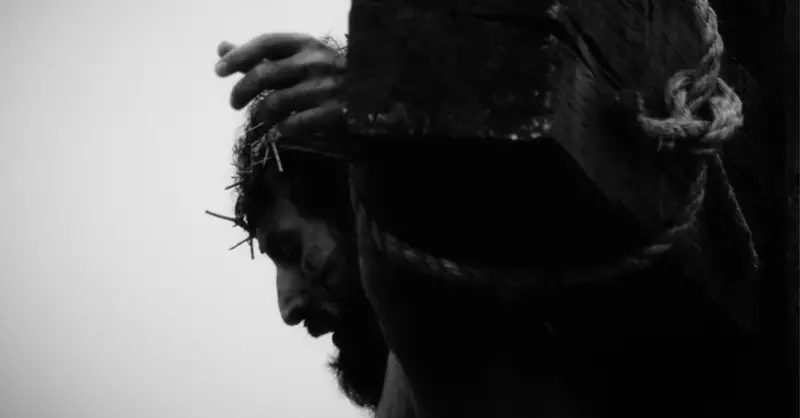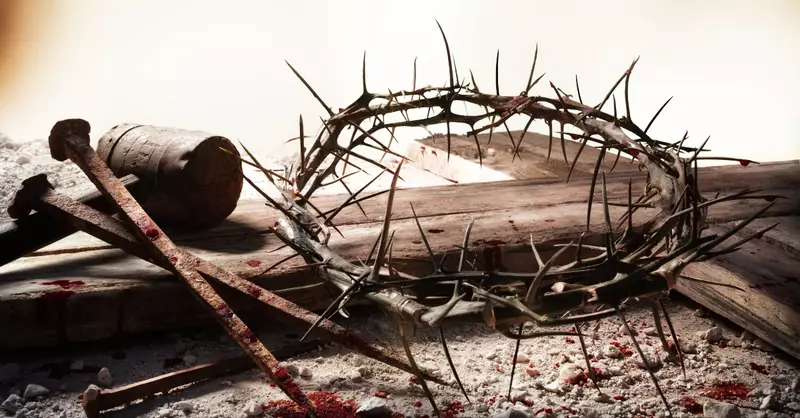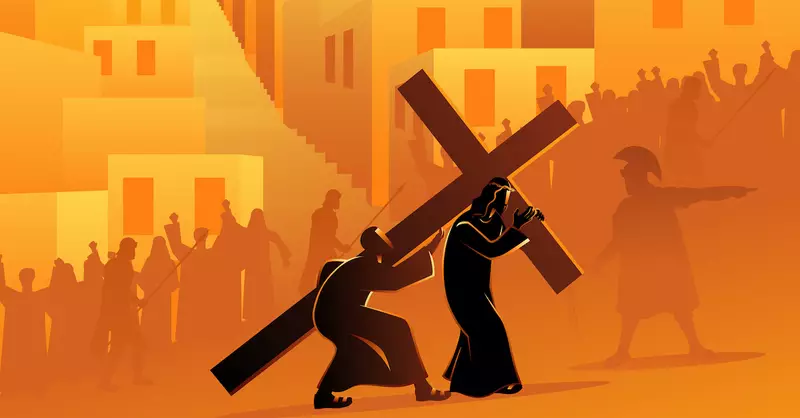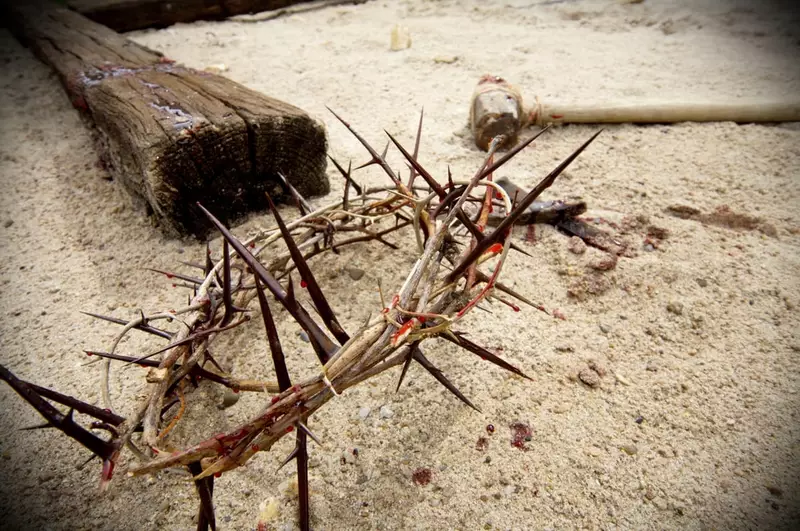The crucifixion of Jesus is one of the most significant events in Christian history. It is a moment that is deeply embedded in the collective memory of the Church and has been the subject of much study and reflection. While the details of the crucifixion are widely known, there are still some interesting curiosities about Jesus on the cross and the crucifixion that may surprise you. In this article, we’ll explore some of these lesser-known facts and delve into the mysteries of Jesus’ death on the cross.
Curiosities about the crucifixion of Jesus on the cross
Jesus of Nazareth was born in the city of Bethlehem, in a humble stable. He was the son of Mary and Joseph, worked as a carpenter, and had at least 4 more siblings. He learned Torah as a child and was obedient to his earthly parents and heavenly Father. He started his ministry at age 30, was baptized, healed, instructed, made friends, made disciples, changed thousands of stories, and enchanted millions of hearts.
He was humble unto death, even death on a cross.
On a Friday, the same Jesus went through the 6 most agonizing hours of his human life. He was betrayed, arrested, denied, flogged, wounded, crucified, and killed.
His passion for humanity led him to the cross. His carpenter’s hands, which once also scribbled on the floor, were nailed to the wood, shamelessly bruised.
“But he was pierced for our transgressions, he was crushed for our iniquities; the chastisement of our peace was upon him, and by his stripes, we are healed.” (Isaiah 53:5 – ACF).
Today, we remember the Christ who took upon himself everything that was meant to be ours. We remember his hands, his face, and his words: “It is finished!” We remember the crucifixion.
In honor of this, we have prepared 7 Curiosities about the crucifixion of Jesus on the cross. Good reading!

The world before and after Christ
It is not possible for us to understand everything that happened on the day of Christ’s death if, before that, we do not know the prophecies already described about his coming, his death, and his resurrection.
Prior to the birth of Jesus, approximately, over 300 prophecies were made about the coming of the Messiah – the son of God – to earth.
Prophecies about Christ’s death and crucifixion
Regarding the prophecies related to Christ’s death and crucifixion, Psalm 22 and Isaiah 53 certainly stand out. See some examples:
- His hands and feet pierced – Psalm 22:16 and John 20:25.
- His bones would not be broken – Psalm 22:17 and John 19:33.
- Men would cast lots for the Messiah’s clothing – Psalm 22:18 and Matthew 27:35.
- Jesus would be rejected – Isaiah 53:3 and Luke 13:34,
- He would be silent in front of his evildoers and accusers – Isaiah 53:7 and 1 Peter 2:23.
- He would be killed, in order to complete the atoning work for the sins of his people – Isaiah 53:5-9 and 2 Corinthians 5:21.
- Die alongside criminals – Isaiah 53:12 and Mark 15:27
- He would be buried with the rich – Isaiah 53:9 and Matthew 27:57-60
All these prophecies were fulfilled in Jesus. He came so that the ancient animal sacrifices would be done away with, as he became the perfect lamb. He came to fulfill the Law, changing our relationship with it, and beyond that: Jesus fulfilled the Law perfectly, both moral and ceremonial laws., taking us back to the Lord, with free access.
Today, we are free.
“It was for freedom that Christ set us free.” (Galatians 5:1a).
7 Curiosities about the crucifixion of Jesus on the cross
Below are some of these curiosities and uncover the truth behind the crucifixion of Jesus

1. The invention of the death penalty by crucifixion
The death penalty by crucifixion was created by the Persians during the 5th century BC. In the West, this type of feather was brought by Alexander the Great. However, its popularization occurred in the Roman Empire – when Judea was occupied by Rome. The custom was to punish rebellious slaves, violent criminals, and traitors who opposed the empire with this kind of death.
Crucifixion, then, in addition to being one of the cruelest forms of torture in history, aimed to expose the condemned to public execration.
2. Barabbas
On the occasion of Christ’s arrest and accusation, the Jews celebrated Pesach (Passover) which was traditionally a celebration of the freedom of the Hebrews conquered in Egypt. Easter was then the most important traditional religious festival.
Thus, on these specific Jewish commemoration dates, Jerusalem was filled with pilgrims from all over Israel, which explains the presence of Governor Pontius Pilate in the place, given the need to maintain political control in the region.
Still, on that special date, Pilate had the custom of releasing a criminal – the one chosen by the people. On that occasion, the “options” were Jesus Christ and Barabbas – described in the bible as an agitator (leader of an anti-government revolt), robber, and murderer.
Barabbas thus deserved the death penalty by crucifixion, however, the people cried out for the release of Barabbas, so that Jesus would be sentenced to death.
Pilate, in turn, makes several attempts not to execute Jesus – since he did not find in Christ any reason to condemn him. He sends him to the scourging (which will be explained below), then washes his hands, in order to be free from the blood of Jesus.
Still, the ideological controversies maintained by the Sadducees and Pharisees, as well as the clamor of the people for Christ to be crucified, led to his death.
It is not known what happened to Barrabás after this episode. However, one thing is certain: he was just like you and me. We both deserved death, we both received deliverance – the other died that we might live.
3. The scourging
After the arrest of Jesus – driven by the betrayal of his friend and disciple Judas – the religious of the Sanhedrin took the Nazarene to a “trial”, in order to find reasons so that they could condemn him to death immediately.
Afterward, Jesus is taken to Pilate, and as already mentioned, the governor condemns him to flogging.
The condemned to flogging, at that time, was placed without clothes in the upper part and with his hands tied. The whips used by the soldiers were made of ropes or leather strips, with bones or pieces of iron or lead at each end.
The first lashes tore the flesh, causing the blood to flow from the veins in abundance. These, directly hit the back, while the ends of the whip curled up in the body and hurt the chest and belly.
After the number of floggings ordered to the condemned, the veins and viscera of the flagellates were often exposed, with the face also disfigured by the blows. The consequences of this punishment were bleeding, accumulation of blood and fluid in the lungs, and possible laceration of the spleen and liver.
The Bible makes it clear that Jesus endured everything patiently and quietly like a mute sheep led to the slaughter.
4. The Mocking of Roman Soldiers and the Crown of Thorns
After the scourging, the soldiers put on Jesus a soldier’s cloak, scarlet red, to mock him as the garment of a king.
As if that wasn’t enough, they wove a crown of thorns and placed it on Jesus’ head, hitting it with a scepter made of reeds, so as to sink the sharp thorns even deeper into Christ’s head.
Satisfied, the soldiers began to simulate a sarcastic tribute to Jesus, kneeling before him and crying out: Hail, King of the Jews! And they spit in his face, slapped him, and cruelly mocked Jesus.
At the time of the crucifixion, they carved a plaque whose writing was pronounced in 3 different languages: “Jesus Nazarene, king of the Jews”.

5. The cross and the nails in the hands
Contrary to what we commonly think, Jesus was not nailed with nails in the palms of his hands, but in his wrists. If the nails had been driven into the palms, they would easily have been torn apart by the weight of the body, causing Jesus to fall from the cross.
Most studies point out that the cross of Christ was a “crux immissa”, in the shape of a “T” and with a vertical tip slightly longer than the horizontal one.
The information most accepted by historians and theologians is that Jesus only carried the horizontal part of the cross, called the “patibulum”, which weighed about 27 kilograms. The route taken by Jesus with the cross (or patibulum) on his back, to Mount Caveira (or Calvary) was about 600 meters long.
6. The death on the cross, the two thieves, and the last words of Christ
Those condemned to the penalty of crucifixion normally died from dehydration, asphyxiation, and suffocation – due to the head hanging over the chest.
To abbreviate death, soldiers used to break the legs of convicts so that they would no longer support the body, as this facilitated asphyxiation.
Jesus, however, did not have his bones broken, nor did he even accept to drink the wine offered by the soldiers to numb his pain.
Beside him were two thieves, who mocked Jesus, telling him to come down from the cross. One of them, however, about to die, regretted what he had said and declared:
“But the other criminal rebuked him, saying, “Do you not fear God, even being under the same sentence? We are being justly punished because we are getting what our actions deserve. But this man has done no wrong.” Then he said, “Jesus, remember me when you come into your Kingdom.” Jesus answered him, “I assure you, today you will be with me in paradise.” (Luke 23:40-43).
Jesus died committing his spirit to God. Just before he died, however, he uttered the words that would change world history forever: “It is finished,” he said, and there all prophecy and all laws were fulfilled.
7. The body of Jesus
Jesus died at approximately 3 pm on Friday afternoon. As we know, at that moment the earth shook, the veil of the temple was torn from top to bottom, and the dead were raised.
As for the body of Jesus, the four gospels state that, after the crucifixion of Christ, Joseph of Arimathea asks Pontius Pilate to hand it over to him. After his request was granted, Joseph removes the body from the cross with the help of Nicodemus, wraps it in a linen cloth, and deposits it in a tomb that was his.

